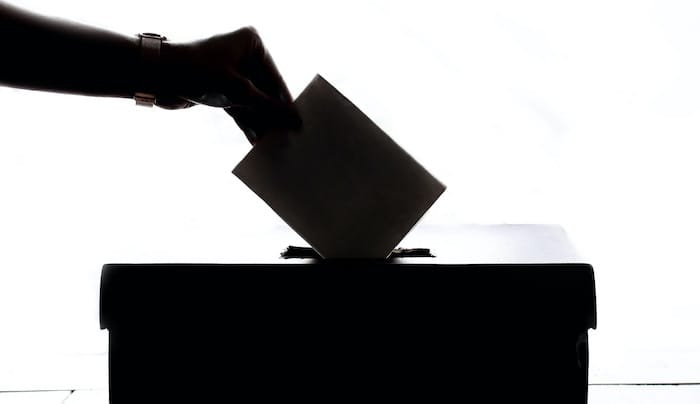Lauren Slade, maths graduate and aspiring barrister, explores the lack of statutory protection for blind and partially-sighted voters at the UK elections

Following the Conservative by-elections of 20 July, now is perhaps a good time to reflect on the inadequate arrangements for blind and partially sighted voters (referred to as ‘blind voters’ for brevity) at elections, particularly since the passing of the Elections Act 2022.
The conduct of parliamentary elections in the UK is governed by rules contained in the Representation of the People Act 1983 (‘RPA 1983’). Prior to the Elections Act 2022, Rule 29 of Schedule 1 to the RPA 1983 provided that a Returning Officer was under a duty to equip each polling station with a “device of such description which may be prescribed for enabling voters who are blind or partially-sighted to vote without any need for assistance from the presiding officer or any companion”.
This power was exercised by regulation 12 of the Representation of the People (England and Wales) Regulations 2001, which described a device known as the Tactile Voting Device (TVD).
A TVD is a transparent, plastic sheet which fits over a ballot paper and has numbered tabs on its side. Each of these correspond to a different candidate and can be lifted to allow the voter to mark the paper next to their chosen candidate’s name.
In 2019, the provision of TVDs at elections was condemned by Mr Justice Swift as a “parody of the electoral process” in a judicial review brought by blind voter Rachael Andrews, in which she successfully argued that the device did not meet the requirements of Rule 29 because it did not enable blind voters to vote without any assistance.
As blind voters are unable to read the list of candidates on the ballot paper, the only way they can know which numbered tab on the TVD corresponds to which candidate is to memorise the order in which the candidates are listed before entering the voting booth.
This, Andrews argued, is an arduous task – especially if there are numerous candidates, as there often are, in local by-elections. In practice, it is a task that she, like many other blind voters, is unable to perform without assistance.
The Royal National Institute of Blind People (RNIB) estimated that in the May 2021 elections, four out of five blind voters were unable to vote independently and without anyone else knowing their choice of candidate.
Often the blind voter’s companion must be made aware of their vote in order to assist, and if they have to verbalise their choice, then other voters and workers at the polling station may also become aware of their vote.
Troubling written evidence submitted by RNIB during the passage of the Elections Act 2022 quoted blind voters who felt “humiliated”, unsure if their helper had voted as they wanted and who had even heard fellow voters at the polling station “audibly sigh” upon overhearing their choice of candidate.
Want to write for the Legal Cheek Journal?
Find out moreDespite this evidence and Andrews’ successful judicial review, the Elections Act 2022 has arguably further downgraded the statutory protection for blind voters. The 2022 Act amended Rule 29 such that a Returning Officer now has to provide each polling station with “such equipment as it is reasonable to provide for the purposes of enabling, or making it easier for, relevant persons to vote independently in the manner directed by rule 37”. This amendment is undesirable for three main reasons.
Firstly, the requirement for the provision of a TVD specifically has been replaced with a requirement for merely what it is ‘reasonable’ for the Returning Officer to provide. This is arguably open to interpretation and could create what RNIB refers to as a ‘postcode lottery’ where equipment available for blind voters could vary at polling stations across the UK.
While the TVD was unsatisfactory, it is now possible that even this bare minimum of equipment could be unavailable at some polling stations. A more desirable alternative would have been for the relevant regulation to provide for an audio player alongside the TVD that would play the candidates’ names as they appear on the ballot. This system was trialled by the Cabinet Office, with the support of RNIB, at polling stations in Norfolk in the May 2021 elections with outstanding results: 91% of blind voters were satisfied.
The second problem is the change by the Elections Act 2022 of the purpose of the provision from allowing blind voters “to vote without any need for assistance” to being able “to vote independently in the manner directed by rule 37 (including in relation to voting secretly)”. RNIB argued correctly in its written evidence that this new phrase was not as clear as to the rights provided as the former.
But further, it should be noted that in Rachael Andrews’ judicial review, the Minister for the Cabinet Office argued that the words “to vote” should be construed as merely meaning to mark the ballot paper in one of the areas indicated, and that whether it corresponded to the voter’s candidate of choice or not was irrelevant.
The judgment states that counsel for the Minister referred to the “provisions of the rules themselves” in support of this argument. While it is not explicit that Rule 37 was one such rule, Swift J later refers to Rule 37(5) prescribing that a voter merely be able to “…secretly mark his paper…” in addressing this submission. Even if Rule 37 was not cited by counsel, it arguably had the potential to be.
Although Swift J thankfully afforded the words “to vote” their common-sense meaning, he had to depart from the conclusion of Hickinbottom J in an application for permission to apply for judicial review (and, reportedly, the conclusion of Blake J in the renewed application) to do so. Furthermore, the High Court judgment is not binding on superior courts, so there is no guarantee that a similarly benevolent construction would be employed if the case, or one similar to it, went to appeal.
It is therefore perhaps worrying that Rule 37 is now directly referenced as the standard by which being able to vote independently is measured.
Finally, instead of the provision in Rule 29 existing for the purpose of “enabling” blind voters to vote independently, the phrase is now “enabling, or making it easier for”. One could argue that, on a literal interpretation, equipment provided to blind voters has achieved its purpose if it has merely made it ‘easier for’ independent voting, even if this has not been fully facilitated.
While this change was likely included in light of the 2022 Act’s aim to “look at accessibility more broadly”, to help ensure voters with other disabilities also receive the adaptations they require, it offers no more protection than the ‘reasonable adjustments’ already required by the Equality Act 2010, as RNIB noted in its written evidence.
While the aim of the Elections Act 2022 to improve access to voting for all disabled people is admirable, it should not be at the expense of the protection afforded to blind voters.
Given the simplicity of the audio player and its enormous success at trials, the absence of any term in the 2022 Act ensuring that this TVD-audio-player system is available at all polling stations across the UK is disappointing to say the least. Instead, the wording of Rule 29 has been weakened to the extent that the provision of the TVD itself is now uncertain.
These challenges are perhaps more worthy of the extensive media coverage received by the by-elections than the tumultuous political situation they reveal.
Lauren Slade holds bachelor’s and master’s degrees in maths from the University of Bath and Imperial College London. She is an incoming bar course student at the Inns of Court College of Advocacy and an aspiring barrister.
 (
( (
(
